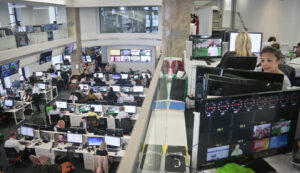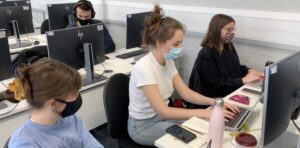
It’s 9:30am on a Monday morning and you arrive at your desk, optimistic. Coffee in hand, you sit down and open your emails. Kicking off your slippers, you get down to work in your own front room. Welcome to the reality for a growing number of journalists: flexi-working, which allows employees to work from home either part-time or full-time.
More companies are turning to flexible working in an effort to cut costs, as surveys reveal that office space is the second-biggest expense for organisations. 2017 was a year in which Time Inc, Condé Nast and Bauer Media circulation figures were all down by around 7% year on year, and media companies are looking to save money wherever they can. But is flexi-working the best way forward for journalists and their employers?
A recent survey from Cisco Systems, the worldwide leader in IT and technology, found that direct personal interaction drives innovation, and flexible working limits this. XCity Plus spoke to Mark Beesley, group HR director at News UK. “Working from home or other flexible arrangements are a great retention tool but need to be used sensibly,” he says. “A newsroom is just that – and works best when people are in close proximity, and staff would be less efficient if they were not co-located.”
Journalism is a job of “collective creativity”, as former Vogue editor Alexandra Shulman put it in her 2013 Guardian article, condemning working from home. Of course, the advances of technology mean that we can now “telework” via email and video conference calls. But, like Shulman points out, it’s the very act of being in the office and sharing small talk with co-workers that can spark ideas for some of the best features; not to mention the nightmare that comes from trying to change a layout, or check a fact over email, rather than being able to simply walk over to a colleague’s desk.
While flexi-working increases employee diversity because it allows mothers the flexibility of working from home, Julia Llewellyn Smith – who freelances for The Times, The Sunday Times and The Telegraph – shared her concerns over the lack of face to face interaction caused by flexible working. “Contact is made increasingly on email. There are people who I’ve worked with for five years and I’ve never heard their voice.”

In 2017, IBM, formerly recognised as a pioneer of remote work, announced that it would be recalling its workers to regional offices (either that or they lost their jobs). The company recognised that what they were saving on office space, they were losing in terms of productivity and collaboration.
It’s a move that other tech giants, such as Apple, have also made – with Apple Park, its new 26,0128 square metres office built to house their over 12,000 staff opening in April 2017. They’re recognising how shared environment promotes productivity.
Productivity is something that Clare Dowdy (International, 1994) struggled with when she began working at home. Now editor of Furnace, a digital magazine that champions industry, she worked at home for a matter of months before realising that lack of human contact was reducing her efficiency. “I felt that I had very low productivity,” she recalls. “Some days I could barely get on with the piece even though I had a deadline. As I lived alone it was demoralising that the only person I would speak to that day was a PR.”
Beesley echoes this. He says that permanently working from home risks isolation and over work. “People don’t have start and end times and work bleeds into time which should be spent relaxing or doing family things,” he says.
A recent PLOS study, “Social Relationships and Mortality Risk”, found that the loneliness associated with home hot-desking could lead to an early death, due to a weak social relationship, while another, by the University of Sacramento and the University of Pennsylvania, concluded that the loneliness that a worker felt directly correlated to the lack of passion and commitment they felt for their publication. The latter is something that companies are now recognising as they begin to make the move back to the traditional workplace.
Beesley says it’s about finding the delicate balance: “Better technology makes things possible now that weren’t 10 years ago, but I think companies will closely examine the unintended consequences of a scattered workforce. Companies, like ours, have many jobs which could be done from a different location; but staff still need to be in a team and not splintered across home locations, because the work requires close teamwork.”

















